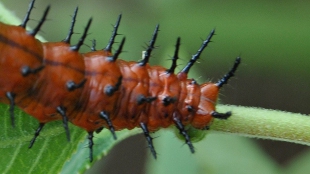 FLICKR, STEVE WILSON
FLICKR, STEVE WILSON
Plants anticipate and curtail tissue damage caused by herbivores through a sophisticated defense mechanism regulated by hormone signaling and the circadian clock. In a study published this week in the Proceedings of the National Academy of Sciences, researchers from Rice University report that Arabidopsis thaliana plants suffer less tissue damage when their internal clocks are in synch with predators such as the cabbage loopers caterpillars. They found that right before daytime, when caterpillars are most likely to feed on the plant, in synch plants increase the production of the jasmonate hormone, which helps interfere with insect digestion. Plants with deficiencies in jasmonate, or whose internal clocks were out of phase with the caterpillars, suffered more tissue damage.
"Jasmonate defenses are employed by virtually all plants, including tomatoes, rice, and corn," Rice University’s Wassim Chehab, one of the authors of the paper, said in a press release...



